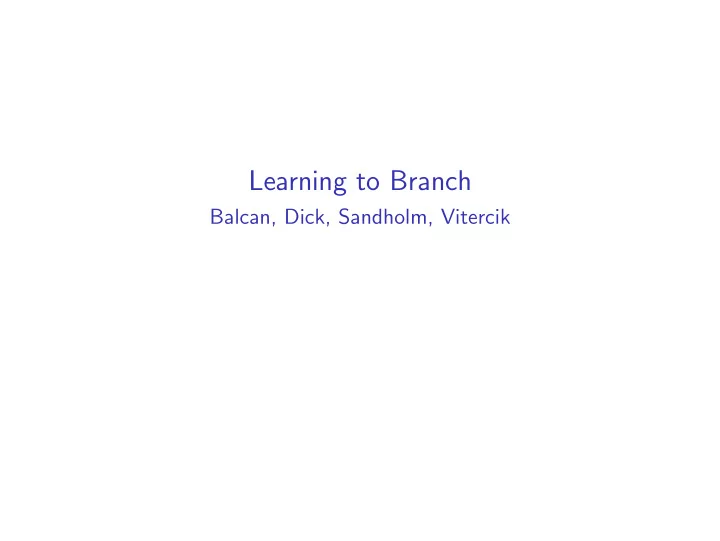

Learning to Branch Balcan, Dick, Sandholm, Vitercik
Introduction ◮ Parameter tuning tedious and time-consuming ◮ Algorithm configuration using Machine Learning ◮ Focus on tree search algorithms ◮ Branch-and-Bound
Tree Search ◮ Widely used for solving combinatorial and nonconvex problems ◮ Systematically partition search space ◮ Prune infeasible and non-optimal branches ◮ Partition by adding constraint on some variable Paritioning strategy is important! ◮ Tremendous effect on the size of the tree
Example: MIPs Maximize c T x subject to Ax ≤ b ◮ Some entries of x constrained to be in { 0 , 1 } . ◮ Models many NP-hard problems. ◮ Applications such as Clustering, Linear separators, etc. (Winner determination)
Model ◮ Application domain as distribution over instances ◮ Unknown underlying distribution but have sample access Use samples to learn a variable selection policy. ◮ As small a search tree as possible in expectation over the distribution
Variable selection Learning algorithm returns empirically optimal parameter (ERM) ◮ Adaptive nature is necessary ◮ Small change in parameters can cause drastic change (unconventional, e.g. SCIP) ◮ Data-driven approach is beneficial
Contribution Theoretical: ◮ Use ML to determine optimal weighting of partitioning procedures. ◮ Possibly exponential reduction in tree size. ◮ Sample complexity guarantees that ensure empirical performance over samples matches expected performance on the unknown distribution. Experimental: ◮ Different partitioning parameters can result in trees of vastly different sizes. ◮ Data-dependent vs worst-case generalization guarantees.
MILP Tree Search ◮ Usually solved using branch-and-bound. ◮ Subroutines that compute upper and lower bound of a region. ◮ Node selection policy. ◮ Variable selection policy (branch on a fractional var). Fathom every leaf. A leaf is fathomed if: ◮ Optimal solution to LP relaxation is feasible. ◮ Relaxation is infeasible. ◮ Obj. value of relaxation is worse than current OPT.
MILP B & B example
Variable selection ◮ Score-based variable selection ◮ Deterministic function ◮ Takes partial tree, a leaf and a variable as input and returns a real value Some common MILP score functions: ◮ Most fractional ◮ Linear scoring rule ◮ Product scoring rule ◮ Entropic lookahead
Learning to branch Goal: Learn convex combination of scoring rules that is nearly optimal in expectation. µ 1 score 1 + ... + µ d score d ( ǫ, δ )-learnability
Data-independent approaches ◮ Infinite family of distributions such that the expected tree size is exponential in n. ◮ Infinite number of parameters such that the tree size is just a constant (with probability 1).
Sample complexity guarantees Assumes path-wise scoring rules. ◮ Bound on the intrinsic complexity of the algorithm class defined by range of paremeters. ◮ Implies generalization guarantee.
Experiments
Stronger generalization guarantees In practice, number of intervals partioning [0 , 1] << 2 n ( n − 1) / 2 n n ◮ Derive stronger generalization guarantees.
Related work ◮ Mostly experimental ◮ Node selection policy ◮ Pruning policy
Thank you
Recommend
More recommend